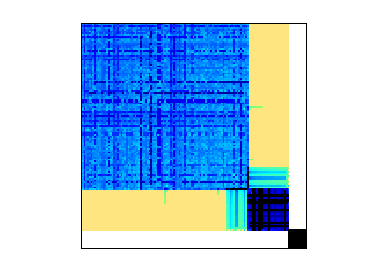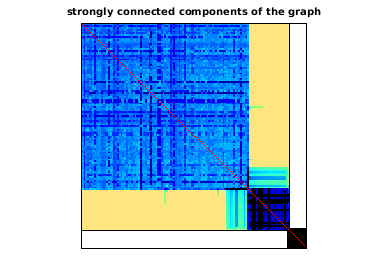Sybrandt/MOLIERE_2016
MOLIERE: Automatic Biomedical Hypothesis Generation System
| Name |
MOLIERE_2016 |
| Group |
Sybrandt |
| Matrix ID |
2810 |
|
Num Rows
|
30,239,687 |
|
Num Cols
|
30,239,687 |
|
Nonzeros
|
6,669,254,694 |
|
Pattern Entries
|
6,677,301,366 |
|
Kind
|
Undirected Weighted Graph |
|
Symmetric
|
Yes |
|
Date
|
2017 |
|
Author
|
J. Sybrandt, M. Shtutman, I. Safro |
|
Editor
|
T. Davis |
| Structural Rank |
|
| Structural Rank Full |
|
|
Num Dmperm Blocks
|
|
|
Strongly Connect Components
|
28,946 |
|
Num Explicit Zeros
|
8,046,672 |
|
Pattern Symmetry
|
100% |
|
Numeric Symmetry
|
100% |
|
Cholesky Candidate
|
no |
|
Positive Definite
|
no |
|
Type
|
real |
| Download |
MATLAB
Rutherford Boeing
Matrix Market
|
| Notes |
MOLIERE Hypothesis Generation Network, J. Sybrandt, Clemson Univ.
Justin Sybrandt, jsybran at clemson.edu
Matrix Name: MOLIERE_2016 Hypothesis Generation Network
Kind/Problem Domain: Term/Document Graph
This network was presented in "MOLIERE: Automatic Biomedical Hypothesis
Generation System (KDD'17)." Nodes in this network are either MEDLINE
documents, UMLS terms, or n-grams we extracted through ToPMine.
citation:
Justin Sybrandt (Clemson University, Clemson, SC, USA),
Michael Shtutman (University of South Carolina, Columbia, SC, USA)
Ilya Safro (Clemson University, Clemson, SC, USA),
"MOLIERE: Automatic Biomedical Hypothesis Generation System",
23rd ACM SIGKDD Conference on Knowledge Discovery and Data Mining
August 13-17, 2017, Halifax, Nova Scotia - Canada
https://doi.org/10.1145/3097983.3098057
The original data was 0-based with nodes numbered 0 to n-1. Converted
to 1-based for the SuiteSparse Matrix Collection, July 2018.
The graph has n=30,239,687 nodes. Node labels are held in the char array
Problem.aux.labels. Nodes 1 to 22,281,874 all have labels starting with
the capital letter "P", and are PubMed indentification numbers of the
MEDLINE documents. Nodes 27,683,534 to n all start with the letter "C",
and refer to UMLS terms. Nodes between these two sets of nodes refer to
n-grams; none of them start with P or C (or any capital letter). The
label of the kth node is also the kth line in the labels text file, and
to the kth row and column of the matrix.
The graph has 4,023,336 explicit zero edges, which are very important
to the problem. They link automatically mined n-grams to UMLS terms
representing the same concept. The goal is to find shortest-paths,
so an edge of zero-length is important, and not the same as no edge
at all. The pattern of the explicit zeros is held in Problem.Zeros
in the MATLAB representation, and are part of the files for the Matrix
Market and Rutherford-Boeing formats. To operate on the graph G in
MATLAB, use G = Problem.A + 1e-100 * Problem.Zeros, or some other
suitable tiny value. The nonzero edge weights in the graph range in
value between 5e-15 and 3.0. There are no negative edge weights.
The graph also has d=3,106,164 duplicate edges; it could be considered
a multigraph. However, since the problem is to find shortest paths, the
duplicate edges are not needed. The matrix in the SuiteSparse Matrix
Collection holds the smallest edge weight for any duplicate. The
duplicates not in the matrix are held in Problem.aux.duplicate_edges,
as a d-by-3 dense matrix, where each row holds [i j eij] for the edge
(i,j) with weight eij.
|

